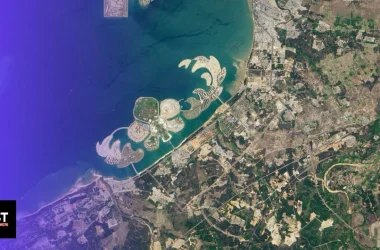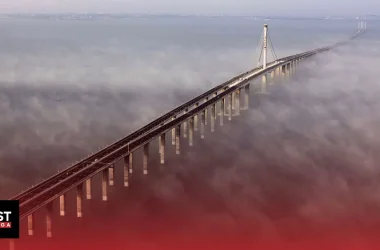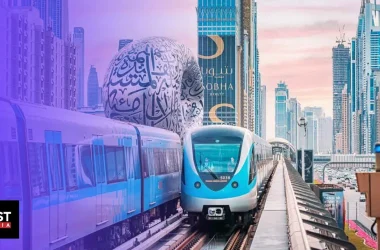Welcome to the bustling Colombo port, the beating heart of Sri Lanka’s maritime trade. Ships carrying two-thirds of the world’s oil and half of all container shipments pass through these waters giving Sri Lanka’s ports huge strategic significance.
Its importance is not lost on China, which stands accused of sending suspicious ships and even submarines into its port on the island.
Now, in a daring geopolitical power play, the United States has unveiled a blockbuster $553 million investment in Sri Lanka’s Colombo port. Most surprising of all, the US is giving this money to the allegedly corrupt Adani Group whose Founder and Chairman is a close friend of Indian Prime Minister Modi.
What is going on behind the scenes at Sri Lanka’s Colombo port? And is the emerging U.S.-India alliance enough to weaken China’s hold over the island nation?
Why Sri Lanka?
While Sri Lanka is a beautiful country, the reason these global powers are investing in it has nothing to do with its resources or its exports, instead it all boils down to its location.
More than 40,000 ships travel along the East-West shipping route each year passing Sri Lanka’s Colombo port in the process. These ships carry two-thirds of the world’s oil and half of all container shipments.
So it’s easy to see why Sri Lanka has become a point of interest for China and India especially since Sri Lanka shares its maritime borders with India and the Maldives.
And now the U.S. has decided to join in by announcing an investment of $553 million in developing Colombo port’s west container terminal.
This decision may have surprised a few people considering that China invested $1 billion in building the Hambantota port just 20 years ago only for it to fail.
The Hambantota port – where it all began
The Hambantota port is the island’s second largest on the southern coast. At first, it seemed like a good idea thanks to its strategic location near the busy shipping routes in the Indian Ocean which is why Sri Lanka hoped it would boost its commerce and global trade. But that didn’t happen.
When it opened in 2010, the port was barely operational and because the Sri Lankan government didn’t invest enough in the port’s operations, trade progressed very slowly. Failing to pay back its debts, Sri Lanka eventually agreed to lease the port to China for 99 years, with the state-controlled China Merchants Port Holdings investing $974 million in exchange for nearly a 70% stake in the port in 2017.
Ultimately, the port didn’t really yield the results that Sri Lanka was hoping for, but did it achieve what China had hoped for?
That’s a question many American and Indian critics have asked. In fact, the Hambantota International Port is likely the most well-known Chinese investment in Sri Lanka since it is often pointed to as an example of what could be the real motives behind China’s Belt and Road Initiative.
Increasing tensions in the region
Sri Lanka was on the brink of collapse in 2022 and since the country was basically bankrupt, it was also struggling with political instability. But in the midst of all the protests a strange Chinese vessel sailed in and docked at Hambantota port.
This was supposedly a Chinese “scientific research” vessel, but its arrival set off alarm bells in the West and in India.
Some foreign security experts said the ship was actually a “naval ship that’s been used in the past to track satellites and missiles”. These experts also expressed concerns over the possibility that China would use its newly acquired port for military purposes.
Taking advantage of the economic crisis they had helped create, China could use the port’s strategic location to advance its territorial or military goals. But these concerns weren’t just limited to Sri Lanka, they extended to all the other countries that had infrastructure projects built because of China’s BRI as well.
Sri Lanka’s predicament over the Hambantota port gave credence to a growing concern in the US: If these countries could not pay back China, would it use its influence to establish a military presence in those regions as well?
U.S. investment
This brings us back to the US’ $553 million investment in Sri Lanka’s Colombo port.
Right now Sri Lanka finds itself caught up between the 3 powers as the U.S. and India work together to establish a stronger foothold on the island in an attempt to throw China off it.
However, diminishing China’s influence will be hard. The U.S. and India are trying to catch up, after China’s influence in the region and in Sri Lanka has already become very strong.
China operates a terminal at Colombo port, and earlier this year Sri Lanka announced it will build South Asia’s largest logistics complex in a joint venture with the China Merchants Port Holdings Company.
So within the context of this geopolitical power struggle it’s easier to understand why the US is investing $553 million in Sri Lanka’s Colombo port. In fact this investment is just part of the U.S. International Development Finance Corporation or DFC’s efforts to counter China’s Belt and Road Initiative.
Unlike the BRI, the DFC was against giving money directly to Sri Lanka’s government. Instead, it’s investing in the consortium responsible for building the new terminal.
The U.S. government justified this approach explaining that its investments won’t burden foreign governments with sovereign debt and will instead finance the private sector because it’s the main source of sustainable capital for global development. Clearly the US is painting its initiative as a counter to the debt laden approach created by the BRI.
China and India tensions leading to a U.S.-India alliance
Considering that the U.S. sees China as its challenger both geopolitically and economically, it’s not surprising to see the U.S.A. making Sri Lanka its battle ground against China.
But that doesn’t explain India’s involvement…
The tensions between India and China go back to 1962, when the two countries fought their only war against each other over a border dispute. The war ended with India suffering a humiliating defeat.
Despite tensions, no more escalations happened. Likely because both became established nuclear powers and trading partners. Now that China is one of India’s biggest trading partners, both countries want to avoid economic fallout as much as possible.
However, relations have worsened over the past decade, particularly in 2020 when Indian and Chinese troops clashed over the disputed Himalayan border in a skirmish that left at least 20 Indian soldiers dead.
This deadly exchange was possibly triggered by India’s decision to construct a new road to a high-altitude air base along the border. A few more face-offs happened between troops in 2021 and 2022 as the two countries raced to build new infrastructure projects along the disputed areas.
Eventually, India and China took their conflict outside the disputed border and began to compete over political and economic influence in the region. This led them to Sri Lanka where both countries were investing heavily in expanding and developing Sri Lanka’s Colombo port. Clearly they had the same idea, both wanted to cement their hold on the island while countering the other’s.
Neither country was comfortable with the other gaining control of an island that falls right in the middle of one of the world’s busiest and most important shipping routes, and as it turns out neither was the U.S.
Choosing to deepen its economic relationship with India, the U.S. took India’s side which comes as no surprise considering its rivalry with China. This decision is also part of America’s strategy to increase its presence in the Indo-Pacific by making India an important partner.
The controversial Adani Group
So the U.S. investment in the Colombo port really achieves two agendas. The first is to counter China’s ambitions with Sri Lanka and the second is to bring India closer as a partner.
It seems that, contrary to what the U.S. would like people to believe about the DCF, a lot of it boils down to U.S. ambitions abroad.
After all, the consortium receiving this money is 51% owned by India’s largest port operator, Adani Ports & Special Economic Zones Ltd. The other two partners are Sri Lanka’s John Keells Holdings and the Sri Lanka Ports Authority, which have 34% and 15% shares in the project respectively.
This means that most of this investment is going straight into the hands of Gautam Adani, the billionaire head of the Adani Group, who stands accused by U.S. short seller Hindenburg Research of using fraud and market manipulation to fuel its rise for decades.
Aside from these accusations there are also rumors that Gautam Adani’s long-standing ties with the Indian Prime Minister, Narendra Modi, have a lot to do with the company’s role in the project.
Adani Group’s mysterious ability to secure projects outside of India has led to speculation that the Prime Minister has helped pave the way for its overseas expansion and in Sri Lanka’s case it seems doubly so.
The Former Sri Lankan electricity board head, MMC Ferdinando, told its parliament in June that Modi had put pressure on the island’s then-president, Gotabaya Rajapaksa, to give Adani a renewable energy project. Unsurprisingly, the Adani group has denied accusations that pressure from Modi on Sri Lanka has helped them secure projects on the island.
Despite these denials, Adani Ports was pretty happy to announce the investment calling it “a ringing endorsement of the Adani Group” and a favor to Prime Minister Modi’s friend will no doubt help improve bilateral relations as well.
Benefits for Sri Lanka
So, the underlying reason for this $553 million project ultimately boils down to the U.S. and India’s common goal of countering China’s growing influence in the region.
Now that China has become the largest bilateral creditor to Sri Lanka thanks to the BRI, it’s clear that Sri Lanka has just become a new battleground in the U.S.-China power struggle.
But that’s not to say that some good won’t come out of the project.
Geopolitical tensions aside, the American-Indian investment in the port would help boost international trade in Sri Lanka since Colombo port has been operating at more than 90% utilization for two years and needs new capacity. This expansion makes perfect sense and could give Sri Lanka a chance to recover from its economic crisis.
The CEO of the International Development Finance Corporation said that every time the capacity in the port of Colombo has increased, that additional capacity has been absorbed within just a couple of years.
This development also comes just in the nick of time since the port has faced competition from other transshipment ports like Dubai, Singapore, and Salalah over the last 8 years. These ports were better equipped to handle large, modern containerships but since this project will expand the terminal’s depth and length, it will be able to handle ultra large container vessels with capacities of 24,000 shipping containers.
Others are hopeful the terminal project will attract crucial foreign exchange inflows during its economic recovery and help transform the socio-economic landscape across Sri Lanka by bringing thousands of direct and indirect new employment opportunities to the country
Thanks to this and other improvements, Colombo part is expected to have an annual cargo handling capacity exceeding 3.2 million twenty foot shipping containers once it becomes operational in 2025.
The 2021 agreement signed between Adani Ports & SEZ along with local partners is worth $700 million and includes a 35-year build-operate-transfer agreement for West Container Terminal. This gives the private partners a period of 35 years to operate the terminal before it is returned to the Sri Lankan government.
Overall, this public-private partnership will help Colombo port attract a larger number of vessels, to achieve economies of scale and thereby lower freight charges. This will also encourage growth and bring additional foreign exchange to the country.
However, Sri Lanka will still have to navigate the geopolitical minefield carefully. It now finds itself at the center of a tug-of-war between the world’s major powers. China remains a dominant player through its control of Hambantota port but the new US-India partnership seeks to challenge China’s influence.
Sri Lanka’s location makes it strategically important, but also vulnerable. As superpower rivalry in the Indo-Pacific intensifies, the country risks being drawn further into an escalating power game.
For the past 20 years, China has dominated global infrastructure finance with faster and bigger projects. However, defaults like Sri Lanka’s have led to mounting criticism of the BRI. Although the US is trying to counterbalance Asia’s investments with the DFC, it still has a long way to go before it is able to catch up.
Disclaimer
Please visit and read our disclaimer here.









